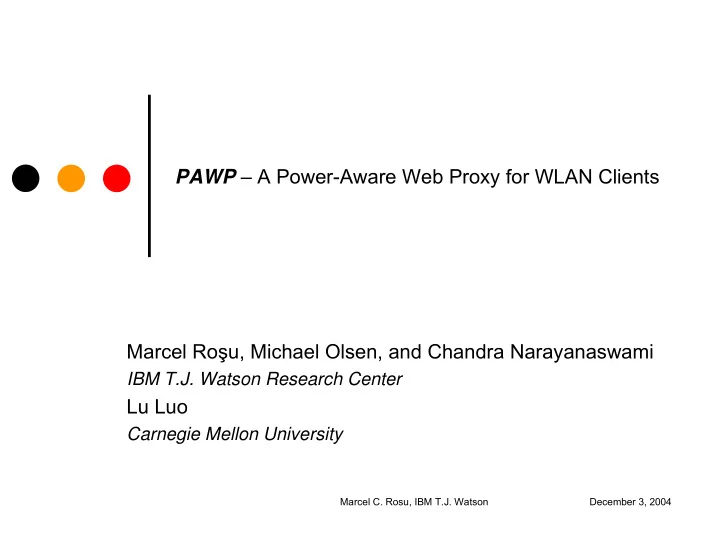

PAWP – A Power-Aware Web Proxy for WLAN Clients Marcel Ro ş u, Michael Olsen, and Chandra Narayanaswami IBM T.J. Watson Research Center Lu Luo Carnegie Mellon University Marcel C. Rosu, IBM T.J. Watson December 3, 2004
Power-Aware Web Proxy Usage Origin Server Wireless Client Firewall Access Wireless Point Client Internet Internet PAWP Proxy Wireless Client Access Point Caching Proxy (optional) Origin Wireless Client Server Origin Server WLANs WMCSA 2004 December 3, 2004
Power Optimization for Wireless NIC Active power consumption in WLAN interface: � � 5-10% in notebooks, 50-90% in PDAs Existing power-reduction approaches for WLAN clients: � � 802.11 Power Saving Mode – limited power saving during active transmissions � MAC level – extending sleep time � Transport level – energy efficient protocols � The unpredictability of incoming traffic causes waste of power Our approach – Power Aware Web Proxy (PAWP), using: � � A web proxy to shape HTTP traffic going into client’s WNIC Based on: � Application domain knowledge � MAC level configuration � Network conditions WMCSA 2004 December 3, 2004
Outline � 802.11 Power Management � Interactions with Incoming WLAN Traffic � PAWP Architecture � Traffic Shaping Rules � Experiments � Testbed � Methodology � Results � Conclusions WMCSA 2004 December 3, 2004
802.11 Power Management � Power Modes � Active � Power Save � Power States � Awake (both Modes, always when listening to beacon from station) • PRISM3 PCMCIA card: 848mW � Doze (Power Save Mode) • PRISM3 PCMCIA card: 25mW � Transition between modes always initiated by station � Frame exchange with access point � Active -> Power Save after idle configurable period � Power Save -> Active after sending/receiving frame WMCSA 2004 December 3, 2004
Analysis of Incoming WLAN Traffic Packet arrival at AP a) Direct (no proxy) (T timeout =100ms) P awake Power Data transferTimeout P doze 6 T beacon 5 T listen Sources of wasted energy in Proposing: Power Aware W/S Proxy that N DATA 4 3 WLAN interfaces modulates WLAN data transmission into 2 1 intervals of high and no traffic Time [beacons] Packet arrival at Proxy b) Proxy (T timeout =25ms) Packet arrival at AP P awake Power P doze 9 T beacon T listen 8 7 6 N DATA 5 4 3 2 1 Time [beacons] WMCSA 2004 December 3, 2004
Comparison on Power Consumption DIRECT 20 mV/div DIRECT 0.5 s/div PROXY 20 mV/div PROXY 0.5 s/div 20 mV/div ACPIspec.pdf eBay.com 0.05 s/div www.eBay.com WMCSA 2004 December 3, 2004
Outline � 802.11 Power Management � Interactions with Incoming WLAN Traffic � PAWP Architecture � Traffic Shaping Rules � Experiments � Testbed � Methodology � Results � Conclusions WMCSA 2004 December 3, 2004
Power-Aware Web Proxy Architecture Oracle Rules Client Side Fetching Blackboard Threads Threads WLAN Clients Web Servers Information per Information per Request Client WMCSA 2004 December 3, 2004
PAWP: Compensating Content Delays Delaying Content Release Compensating for Delays � Prefetch Embedded Objects CurrentTime – TimeOfLastRequest < Ttimeout Y N � Pipeline Requests CurrentTime – TimeOfLastSend < MaxDelay � Pipeline Responses Y N ObjectsReceived >= MinObjects � Prioritize Tasks Y N � Major Challenge TotalBytesReceived >= MinBytes Y N � Handling HTTP Cookies Delay Data Release Release Data WMCSA 2004 December 3, 2004
Outline � 802.11 Power Management � Interactions with Incoming WLAN Traffic � PAWP Architecture � Traffic Shaping Rules � Experiments � Testbed � Methodology � Results � Conclusions WMCSA 2004 December 3, 2004
Experimental Testbed Oscilloscope Power measurement Vdd=3.3V (VellemanPC S64i) environment for wireless client network interface card - + V R Digital Multimeter R=0.53 Ω (HP3458A) Wireless Client Intersil PRISM3 PC Card Data collection (IBM ThinkPad) with Extender PC HTTP protocol trace collection using IBM PageDetailer - Downloading time distribution - Information on web objects - HTTP headers WMCSA 2004 December 3, 2004
Complete, Across-The-Board Experiments � Based on the new experimental testbed � Experiments on each proxy configuration can be done in < 30 sec � Quick, automatic switching between configurations � Measurements in each set are close in time – avoided deviation Direct Proxy1 Proxy2 Proxy3 Proxy4 Direct Proxy1 … … (sec) 0 30 60 90 120 150 180 210 1 st set 2 nd set WMCSA 2004 December 3, 2004
Experimental Results (1) Throughp Website Connection Download Download ut Size [kB] / Num of Objects Type Energy [J] Time [s] [kB/s] cnn Direct 2.47 8.13 34.6 281kB/84 Proxy 2.25 (-9%) 7.33 (-10%) Internet Explorer nytimes Direct 2.36 8.17 30.1 253kB/76 Proxy 1.89 (-22%) 5.78 (-29%) washingtonpost Direct 6.14 9.08 56.0 535kB/73 Proxy 2.83 (-54%) 8.58 (-6%) bbc Direct 2.10 3.56 17.1 61kB/31 Proxy 1.05 (-50%) 3.37 (-5%) cnn Direct 3.30 4.63 54.3 252kB/84 Proxy 1.37 (-59%) 3.88 (-16%) Mozilla nytimes Direct 3.29 6.85 23.3 190kB/45 Proxy 1.11 (-66%) 3.20 (-53%) washingtonpost Direct 4.99 7.34 44.4 504kB/67 Proxy 2.20 (-56%) 7.01 (-5%) WMCSA 2004 December 3, 2004
Experimental Results (2) Relative energy consumption with Proxy vs. Direct case throughput 100.0% Cost and Benefits of Proxy Features 90.0% NY Times (www.nytimes.com) 240kB/77 Download Download Eproxy/Edirect [%] 80.0% Energy [s] Time [s] 70.0% Direct (no proxy) 2.70 8.75 Proxy: all features disabled 2.46 8.95 60.0% Proxy: scheduling, prefetching 2.38 8.05 50.0% Proxy: scheduling, prefetching, request & response pipelining 2.15 7.54 40.0% 30.0% Proxy: all features on 1.94 6.99 0 10 20 30 40 50 60 Throughput [kBps] WMCSA 2004 December 3, 2004
Conclusions � PAWP challenges � No client modifications � Visible to clients � Invisible to servers � Don’t over-shape traffic • Avoid increasing download times � Lessons learned � Page design matters (cookies) � HTTP usage is increasing � PA x P extends savings beyond Web browsing WMCSA 2004 December 3, 2004
Questions? WMCSA 2004 December 3, 2004
Recommend
More recommend